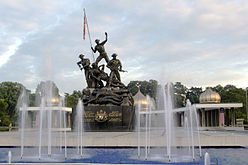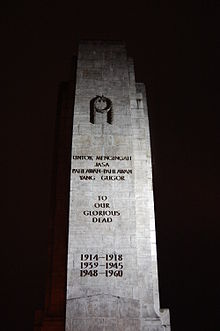- National Monument (Malaysia)
-
National Monument
Tugu Negara
The Malaysian National MonumentGeneral information Type Public monument Location Lake Gardens
 Kuala Lumpur, Federal Territory
Kuala Lumpur, Federal TerritoryConstruction started 1963 Height 15 metres (49 ft) Design and construction Owner Ministry of Culture and Information, Malaysia Architect Felix de Weldon The National Monument is a sculpture that commemorates those who died in Malaysia's struggle for freedom, principally against the Japanese occupation during World War II and the Malayan Emergency, which lasted from 1948 until 1960. It is located in the Federal capital, Kuala Lumpur. The Malaysian Houses of Parliament is situated near the monument.
It is the world's tallest bronze freestanding sculpture grouping. Every year on July 31 on Warriors' Day, the Yang di-Pertuan Agong, the Prime Minister and heads of military and the police pay their respects to the fallen heroes by laying garlands at the monument.
Contents
History
First National Monument
The original national monument was not the one in the form of human figures but was a cenotaph that was situated in the middle of a roundabout. The British administration set up the first monument, a 10m flat grass-covered ground to commemorate the wars and honour the fallen heroes from World War I, World War II and the Malayan Emergency.
It was moved to the present site during the construction of a flyover in 1964 connecting Jalan Sultan Hishamuddin and the Parliament roundabout. Therefore the original name for Jalan Tugu, where the National Monument is currently situated, was Cenotaph Road.
On the monument, it is written “To Our Glorious Dead with dates of the First World War (1914-1918), Second World War (1939-1945) and the Emergency (1948-1960).
Second National Monument
The monument was later replaced with the National Monument, an idea mooted by Malaysia's first Prime Minister Tunku Abdul Rahman and was commissioned in 1963. Tunku Abdul Rahman had the inspiration for the monument when he saw the USMC War Memorial statue during his visit to the United States in October 1960. The Tunku then personally met Felix de Weldon for a favour to design the monument. De Weldon was later conferred with the title Tan Sri, the Malaysian equivalent of a high-ranking knighthood.
The huge tall bronze figures of soldiers standing and supporting their fallen comrades, which is opposite Lake Gardens is regarded as the largest bronze monument grouping in the world.
The National Monument was completed and officially opened on February 8, 1966, by the Yang di-Pertuan Agong. It was proclaimed a memorial park dedicated to the 11,000 people who died during the 12-year Malayan Emergency (1948-1960). Thereafter, a wreath-laying ceremony takes place at the monument every July 31 on Warriors Day.
On 27 August 1975, the monument suffered extensive damage due to an explosion set off by a communist terrorist. But the communist had denied their involvement and instead alleged it was the work of the government itself to damage the monument in order to rationalize the rebuilding of the monument statues which was perceived of having statues of the Caucasians to resemble the looks of Malaysians to avoid being alleged racist and any embarrassment on the government part by blaming the communist. It has since been restored to its original state with the new looks on 11 May 1977. A fence was then erected and the complex was declared a protected area between sunset and dawn. Every day at dawn, a soldier raises the national flag and lowers it at dusk.
Minister in the Prime Minister's Department Jamil Khir Baharom has stated that from 2010, the Warriors' Day commemoration service would be held elsewhere after Malaysia's National Fatwa Council guidelines declared the statues "un-Islamic" and potentially idolatrous. Defence Minister Zahid Hamidi added that a new "Warrior's Square" would be built in the country's administrative capital Putrajaya. When asked why the decision was made only after almost four decades of celebrating Warriors' Day at the present site, Jamil evaded comment, saying "Alhamdulillah, we are serious in solving this issue".[1]
Design
Constructed in 1966, the monument is 15 meters (49.21 feet) tall, made of bronze and was designed by Austrian sculptor Felix de Weldon, who was also responsible for the famed USMC War Memorial in Virginia, United States.
The granite base of the monument bears the old coat of arms of Malaysia, flanked on either side by inscriptions in English with Roman script and Malay with Jawi script:
Dedicated to the heroic fighters in the cause of peace and freedom, May the blessing of Allah be upon themThe monument depicts a group of soldiers holding the Malaysian national flag, the Jalur Gemilang, aloft. Each of the bronze figures symbolizes leadership, suffering, unity, vigilance, strength, courage and sacrifice.
Jalan Tugu
In the 1960s, Jalan Tugu was Cenotaph Road named after a monument that was located at the intersection of the road and Victory Avenue which is now called Jalan Sultan Hishamuddin.
Jalan Tugu now connects to the roundabout that leads to the KL KTM Station opposite the National Mosque.
Along the road you will find the Ministry of Health, Town and Rural Planning Department and Jalan Cenderasari, which leads to the various parks in Kuala Lumpur like the Bird Park, Lake Gardens and Butterfly Park.
References
- In honour of our fallen heroes, New Straits Times, December 16, 2005.
- Monuments to honour the dead, The Star, July 28, 2007.
- National Monument "unsuitable" for Warriors' Day, The Sun, March 31, 2010.
Categories:- Buildings and structures in Kuala Lumpur
- Monuments and memorials in Malaysia
Wikimedia Foundation. 2010.


